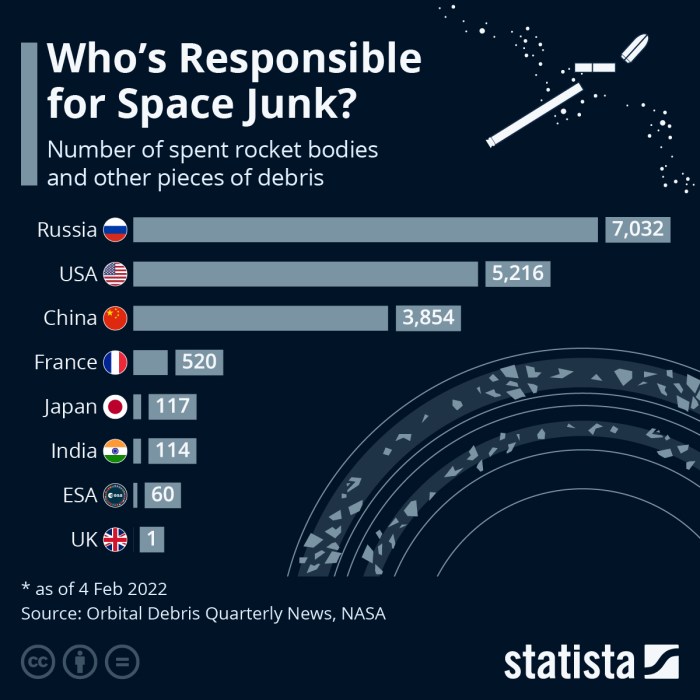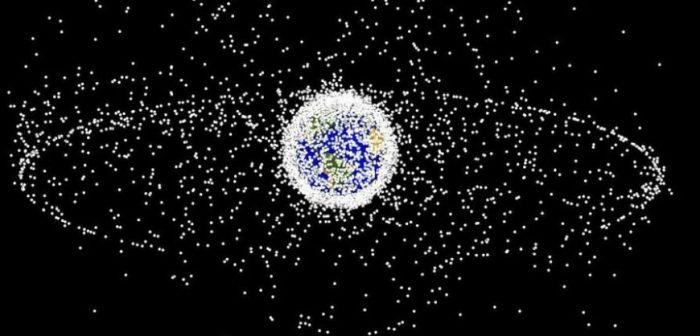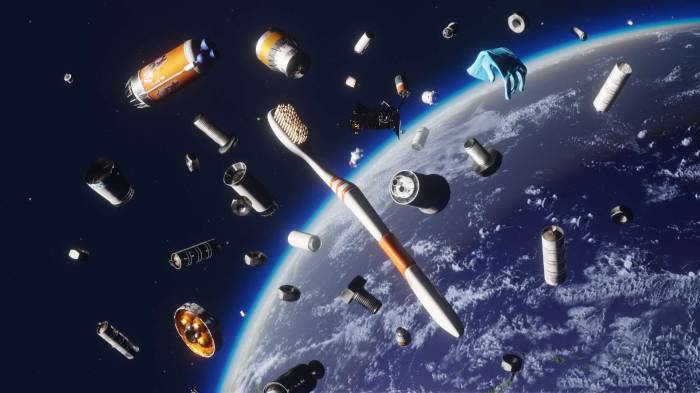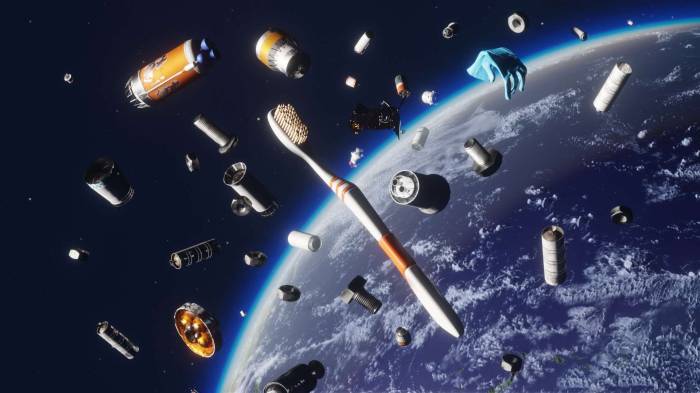The Growing Problem of Space Junk

Governments and private companies need to take responsibility for space junk – The Earth’s orbit is becoming increasingly congested with space debris, a growing concern for the future of space exploration and satellite operations. This debris, ranging from defunct satellites to tiny fragments of paint chips, poses a significant threat to active spacecraft and astronauts.
The History of Space Debris
The history of space debris dates back to the dawn of the space age. The first artificial satellite, Sputnik 1, launched in 1957, marked the beginning of human activity in space. Since then, thousands of satellites, rockets, and other space objects have been launched into orbit, leaving behind a trail of debris.
Early space missions, with their limited technology, often resulted in uncontrolled re-entries, contributing to the initial buildup of space junk.
The Dangers of Space Junk
Space debris poses a serious threat to operational satellites and spacecraft. Collisions with even small debris particles can cause significant damage, leading to malfunctions, loss of functionality, and even catastrophic failures. The high speeds at which debris travels, reaching up to 17,500 miles per hour (28,000 kilometers per hour), exacerbate the impact of collisions.
Statistics on Space Debris
The amount of space debris is steadily increasing. The European Space Agency (ESA) estimates that there are over 100 million pieces of debris larger than 1 centimeter (0.4 inches) in orbit. The United States Space Surveillance Network (SSN) tracks over 27,000 objects larger than 10 centimeters (4 inches) in size.
The Kessler Syndrome
The Kessler Syndrome, proposed by NASA scientist Donald Kessler in 1978, describes a scenario where the density of space debris reaches a critical point, leading to a cascade of collisions. This chain reaction would result in an exponential increase in debris, making space travel and satellite operations extremely hazardous, potentially making Earth orbit unusable for future generations.
Mitigation Efforts
Various efforts are underway to mitigate the space debris problem. These include:
- Developing and implementing debris mitigation guidelines for spacecraft design and operations.
- Tracking and monitoring space debris to predict potential collisions.
- Developing technologies to remove debris from orbit, such as active debris removal spacecraft and laser-based systems.
- Promoting international cooperation and collaboration on space debris management.
Responsibility of Governments: Governments And Private Companies Need To Take Responsibility For Space Junk
Governments play a crucial role in addressing the growing problem of space junk. Their responsibilities extend beyond simply enacting regulations; they also encompass fostering international cooperation, promoting technological advancements, and spearheading initiatives to mitigate the threat of space debris.
International Organizations and Space Debris Mitigation, Governments and private companies need to take responsibility for space junk
International organizations are instrumental in coordinating global efforts to address space debris. These organizations provide a platform for nations to collaborate, share information, and develop common strategies for space debris mitigation.
- United Nations Office for Outer Space Affairs (UNOOSA):UNOOSA serves as the focal point for international cooperation in the peaceful uses of outer space. It facilitates the development of international space law, including guidelines and recommendations for space debris mitigation.
- Inter-Agency Space Debris Coordination Committee (IADC):The IADC is a forum for space agencies from around the world to collaborate on space debris mitigation. It develops technical guidelines and best practices for spacecraft design, operation, and disposal, aiming to reduce the generation of debris.
- International Space Station (ISS):The ISS, a joint venture between several space agencies, serves as a platform for international cooperation in space exploration and research. It has implemented debris mitigation practices, such as collision avoidance maneuvers and debris shielding, setting an example for future space missions.
Regulations and Treaties
International regulations and treaties provide a legal framework for space debris mitigation. These agreements Artikel responsibilities for spacefaring nations and establish guidelines for spacecraft design, operation, and disposal.
- Outer Space Treaty (OST):The OST, signed in 1967, establishes principles for the exploration and use of outer space, including the responsibility of states for activities conducted by their nationals. It also calls for the avoidance of harmful contamination of space and the preservation of its environment.
- Liability Convention:The Liability Convention, adopted in 1972, establishes liability for damage caused by space objects. It clarifies that states are responsible for damage caused by their space objects, including debris.
- Registration Convention:The Registration Convention, adopted in 1975, requires states to register space objects they launch. This allows for better tracking of objects in orbit and helps in identifying potential sources of debris.
Government-Funded Initiatives
Governments have invested in various initiatives to track and remove space debris. These programs utilize advanced technologies and research to develop solutions for mitigating the threat of space junk.
- Space Surveillance Networks:Governments operate space surveillance networks, such as the US Space Surveillance Network (SSN) and the European Space Surveillance Network (ESSP), to track objects in orbit and identify potential collision risks.
- Space Debris Removal Technologies:Research and development efforts are underway to develop technologies for removing space debris. These include active debris removal techniques, such as robotic arms or nets, and passive techniques, such as laser ablation or using a “spacecraft graveyard” for defunct satellites.
- International Cooperation:Governments collaborate through international programs, such as the European Space Agency’s (ESA) Space Debris Mitigation Program and NASA’s Orbital Debris Program, to share knowledge and develop joint solutions for space debris mitigation.
Responsibility of Private Companies
The rise of private space companies has brought about a new era of innovation and exploration in space. However, this burgeoning industry has also contributed significantly to the growing problem of space debris. With their increasing number of launches and satellite deployments, private companies must take responsibility for the space junk they generate.
Assessing Private Companies’ Contributions
Private space companies play a crucial role in the space debris problem. Their activities contribute to the accumulation of space debris in various ways:
- Satellite Launches:Every launch adds to the existing debris population. While many companies are committed to responsible launch practices, there are still instances where launch vehicles malfunction or shed parts, generating debris.
- Satellite Deployed:The proliferation of small satellites, known as CubeSats, has become a major concern. These tiny satellites, often deployed in large constellations, can quickly increase the number of objects in orbit, leading to a higher risk of collisions.
- Spacecraft Breakups:Spacecraft failures and collisions can create large debris fields. This debris can pose a threat to other operational spacecraft and future missions.
Technological Solutions for Space Junk

The growing problem of space debris necessitates innovative technological solutions to mitigate its impact on space exploration and safety. Scientists and engineers are actively researching and developing various methods to remove existing debris and prevent the creation of new debris.
Laser-Based Technologies
Laser-based technologies offer a promising approach to remove space debris. These technologies leverage the power of lasers to exert force on debris objects, altering their orbits and ultimately guiding them towards Earth’s atmosphere for safe disposal. The high-energy lasers can be directed at debris objects, causing them to heat up and vaporize or change their trajectory.
- Laser Ablation:This technique involves using high-powered lasers to ablate (vaporize) a small portion of the debris object. The momentum transfer from the ablated material can slightly alter the debris’s orbit, gradually bringing it down to Earth’s atmosphere for safe disposal.
- Laser Sail:This concept involves attaching a reflective sail to the debris object. A ground-based laser then illuminates the sail, providing thrust and gradually changing the object’s trajectory. This method is particularly suitable for larger debris objects.
Innovative Technologies for Space Debris Mitigation
Beyond laser-based technologies, a range of innovative solutions are being explored to address the space debris challenge. These technologies offer different approaches to capturing, deorbiting, or preventing the formation of debris.
- Electrodynamic Tethers:These long, conductive tethers are deployed from a spacecraft and interact with Earth’s magnetic field. The resulting electromagnetic force can be used to deorbit debris objects, guiding them towards Earth’s atmosphere for safe disposal.
- Space Debris Collectors:These spacecraft are specifically designed to capture and remove debris objects. They can use nets, harpoons, or other mechanisms to capture debris and safely dispose of it. One example is the RemoveDEBRIS mission, which successfully demonstrated the use of a net to capture a simulated debris object in 2018.
- Spacecraft Design Improvements:Incorporating design features into spacecraft that minimize debris generation during launch and operation is crucial. This includes using non-explosive separation mechanisms, designing spacecraft with less detachable parts, and developing self-destruct mechanisms for end-of-life spacecraft.
Nets or Harpoons
Nets or harpoons can be used to capture and remove space debris. The concept involves deploying a net or harpoon from a spacecraft to ensnare the debris object. The captured debris can then be safely deorbited or towed to a designated disposal location.
- Net Capture:This method involves deploying a large net to capture the debris object. The net can be made of strong, lightweight materials, such as Kevlar or carbon fiber. Once the debris is ensnared, the net can be towed or deorbited, bringing the debris safely back to Earth.
- Harpoon Capture:This technique uses a harpoon to pierce the debris object and attach a tether. The tether can then be used to deorbit the debris or tow it to a safe disposal location. This method is particularly effective for larger debris objects.
Future of Space Exploration and Space Junk

The future of space exploration is filled with ambitious plans, from establishing permanent bases on the Moon to sending missions to Mars and beyond. However, these endeavors face a significant obstacle: the growing problem of space junk. The increasing density of debris in Earth’s orbit poses a serious threat to future space missions, potentially hindering progress and even jeopardizing the safety of astronauts.
The Challenge of Managing Space Junk in Future Space Exploration
The challenges of managing space junk are amplified in the context of future space exploration. As we venture further into space, the potential for collisions with debris increases significantly. This is particularly concerning for missions involving human spaceflight, as even small fragments of debris can cause catastrophic damage.
- Increased Mission Complexity:Future space missions will involve more complex and intricate operations, such as assembling structures in orbit, deploying satellites in specific formations, and conducting delicate scientific experiments. The presence of space junk could disrupt these activities, leading to delays, mission failures, and even safety risks.
- Expanding Exploration Zones:As we expand our exploration beyond low Earth orbit (LEO), the density of space junk is expected to decrease. However, this doesn’t necessarily mean the threat is reduced. The larger volume of space to monitor and the greater distances involved make it more challenging to track and mitigate the risks posed by debris.
- Long-Duration Missions:Future space missions, such as those to Mars, will be much longer than previous missions. This means that spacecraft will be exposed to the risks of space junk for extended periods, increasing the likelihood of collisions and potential damage.
Responsible Space Exploration Practices to Prevent Future Debris Accumulation
To mitigate the threat of space junk and ensure the success of future space exploration, it is crucial to adopt responsible space exploration practices. These practices aim to minimize the creation of new debris and actively remove existing debris from orbit.
- Design for Deorbit:Spacecraft should be designed with mechanisms for controlled deorbiting at the end of their operational life. This ensures that they are safely disposed of in Earth’s atmosphere, minimizing the risk of becoming space junk.
- Active Debris Removal:Technologies for actively removing space debris from orbit are being developed and tested. These technologies could involve using lasers, nets, or other methods to capture and deorbit debris.
- International Cooperation:International collaboration is essential for effective space junk management. Sharing data, coordinating debris removal efforts, and developing common standards for responsible space activities will be critical to addressing this global challenge.
- Space Traffic Management:Implementing space traffic management systems is crucial to prevent collisions between spacecraft and debris. These systems could involve tracking debris, predicting its trajectory, and issuing warnings to spacecraft operators.
Visual Representation of the Potential Impact of Space Junk on Future Space Missions
Imagine a future space station orbiting Earth, a bustling hub for scientific research and exploration. Suddenly, a small piece of space junk, no bigger than a marble, strikes the station’s solar panel, causing a cascade of damage. The station loses power, its vital systems fail, and the crew is forced to evacuate.
This scenario, while fictional, highlights the very real threat posed by space junk to future space missions.
Space junk is not a theoretical problem; it is a real and growing threat that could significantly impact the future of space exploration.





